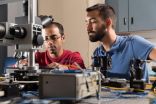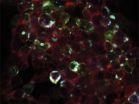(Press-News.org) BALTIMORE, MD (Dec. 16, 2014)--With a unique, multi-faceted approach, researchers at the Lieber Institute for Brain Development (LIBD) have quantified the effect of previously unidentified anomalies in genetic expression that determine how the human brain develops from its earliest stages. Their work, published online December 15th in Nature Neuroscience, offers a novel technique for identifying biological markers in brain development that associate with risk for neurodevelopmental disorders such as schizophrenia and autism spectrum disorder (ASD).
Using state-of-the-art sequencing technology to examine postmortem brain samples from among their vast collection, the research team identified many thousands of differences in gene expression (differentially expression regions or DERs) in the dorsolateral prefrontal cortex (DLPFC) region of the brain across life stages. They examined brains from six distinct life stages--fetal, infant, child, teen, adult and late life--and focused on the DLPFC because of its known association with schizophrenia and ASD. The team used a sophisticated statistical approach called "derfinder" to identify the regions.
"By searching the entire genome for association with the 'derfinder' technique, we were able to identify many segments of the genome that were previously thought to not play an active role in brain development," explains Andrew E. Jaffe, Ph.D., Investigator at LIBD and lead author of the paper.
Following their analysis of 72 human brain samples, the researchers accessed open-source databases to map their identified DERs onto the human genome and to examine expression in 16 different brain regions, in the developing mouse cortex and with human tissue samples and stem cells. They found that genes containing DERs most highly expressed from infancy through adulthood were most associated with important brain signaling and communication mechanisms. The vast majority of DERs were found to be crucial to the maturation process of neurons during fetal development, offering new evidence of how neurodevelopmental disorders may first begin.
"We find that the transition from fetal to postnatal life is the primary driver of differential expression, and the differences appear to represent a 'signature' found in cells from the earliest stages of development," says Dr. Jaffe. The team found the patterns to be similarly expressed across the 16 brain regions, suggesting that the genes containing these DERs function as developmental switches for the brain, regardless of where they are located.
There is significant overlap between these "signatures" of early brain development and regions of genetic risk for schizophrenia identified in the latest international genome-wide association study (GWAS), as well as genes previously associated with ASD and Intellectual Disability, the team reports. Interestingly, the DERs most expressed in the late life stages significantly overlapped other regions of genetic risk for disorders such as Alzheimer's disease and Parkinson's disease.
Daniel R. Weinberger, M.D., Director and CEO of LIBD says that "by linking developmental brain disorders like schizophrenia and autism to specific molecular signatures in early brain development, we are much closer to finding new treatments based on how a brain first gets ill rather than only on how it behaves ill."
The LIBD team concludes that many of the DERs important for brain development--and the developmental "signatures"--contain anomalies not measurable with earlier technologies and approaches, and suggests that the transcriptome, which reflects genes that are actively expressed at any given time, of the human genome accessed in public databases is currently incomplete.
All of the team's data is openly accessible for further analyses in the new Track Hub of the UCSC Genome Browser "LIBD Human DLPFC Development" and through databases maintained by the National Center for Biotechnology Information.
INFORMATION:
About LIBD
The mission of the Lieber Institute for Brain Development is to translate the understanding of basic genetic and molecular mechanisms of schizophrenia and related developmental brain disorders into clinical advances that change the lives of affected individuals. LIBD is an independent, not-for-profit 501(c)(3) organization and a Maryland tax-exempt medical research institution affiliated with the Johns Hopkins University School of Medicine.
Paper: Jaffe A.E., Shin J., Collado-Torres L., Leek J.T., Tao R., Li C., Gao Y., Jia Y., Maher B.J., Hyde T.M., Kleinman J.E., and Weinberger D.R. Developmental regulation of human cortex transcription and its clinical relevance at single base resolution. Nature Neuroscience, 2014, Dec 15. doi:10.1038/nn.3898.
The mortality of larval Pacific oysters in Northwest hatcheries has been linked to ocean acidification. Yet the rate of increase in carbon dioxide in the atmosphere and the decrease of pH in near-shore waters have been questioned as being severe enough to cause the die-offs.
Now, a new study of Pacific oyster and Mediterranean mussel larvae found that the earliest larval stages are sensitive to saturation state, rather than carbon dioxide (CO2) or pH (acidity) per se.
Saturation state is a measure of how corrosive seawater is to the calcium carbonate shells made by ...
Being "average" is often considered a bad thing, but new research suggests that averageness wins when people assess the trustworthiness of a face. The research indicates that, while typical-looking faces aren't seen as the most attractive, they are considered to be the most trustworthy. The new findings are published in Psychological Science, a journal of the Association for Psychological Science.
"Face typicality likely indicates familiarity and cultural affiliation - as such, these findings have important implications for understanding social perception, including cross-cultural ...
ITHACA, N.Y. - Since 1998, hundreds and sometimes thousands of dead eider ducks have been washing up every year on Cape Cod's beaches in late summer or early fall, but the reasons behind these cyclic die-offs have remained a mystery.
A team of scientists from Cornell, Tufts University, University of Georgia, the U.S. Geological Survey and the U.S. Fish and Wildlife Service have pinned down one of the agents responsible: a pathogen they're calling Wellfleet Bay virus (WFBV). Their findings shed light on why eider ducks (also called common eiders) die on Cape Cod every ...
NEW YORK, NY -- Researchers at NYU Langone Medical Center have developed new technology that can assess the location and impact of a brain injury merely by tracking the eye movements of patients as they watch music videos for less than four minutes, according to a study published Friday on-line in the Journal of Neurosurgery.
The study suggests that the use of eye tracking technology may be a potential biological marker for assessing brain function and monitoring recovery for patients with brain injuries.
Led by Uzma Samadani, MD, PhD, chief of neurosurgery at New ...
GALVESTON, Texas -- In the largest study to date evaluating outcomes of Hispanic women with endometrial uterine cancer, researchers at the University of Texas Medical Branch at Galveston have found that Hispanic women in the United States were significantly less likely to survive the cancer than non-Hispanic white women.
A total of 69,764 women diagnosed with endometrial cancer between 2000 and 2010 were included in this study of public-use data from the National Cancer Institute's Surveillance, Epidemiology, and End Results Program. The study is available online in the ...
A team of researchers from the University of California, San Diego have demonstrated a way to emit and control quantum light generated using a chip made from silicon--one of the most widely used materials for modern electronics.
The UC San Diego researchers recently described their new device's performance online in the journal Nature Communications, available via Open Access .
The researchers say practical applications of quantum optics will seem more feasible if devices for generating and controlling these photons can be manufactured using conventional materials ...
It's the most basic of ways to find out what something does, whether it's an unmarked circuit breaker or an unidentified gene -- flip its switch and see what happens. New remote-control technology may offer biologists a powerful way to do this with cells and genes.
A team at Rockefeller University and Rensselaer Polytechnic Institute is developing a system that would make it possible to remotely control biological targets in living animals -- rapidly, without wires, implants or drugs.
Today (December 15) in the journal Nature Medicine, the team describes successfully ...
BOSTON (Dec. 16, 2014) -- Extra vitamin E protected older mice from a bacterial infection that commonly causes pneumonia. Microbiologists and nutrition researchers from Tufts University report that the extra vitamin E helped regulate the mice's immune system. The findings, published online in advance of print in the The Journal of Immunology, show promise for studies investigating the effects of vitamin E and infection in humans.
Older adults over age 65 are at high risk for developing pneumonia, an inflammation of the lungs typically caused by infection. The most common ...
A scientific team at UBC and Providence Health Care have genetically engineered mice with less wrinkled skin, despite repeated exposure to wrinkle-inducing ultraviolet (UV) light.
The youthful-looking mice were bred without the gene that produces Granzyme B, an enzyme that immune cells use to destroy harmful pathogens. The UBC-Providence team, led by Professor David Granville and postdoctoral fellow Leigh Parkinson, found that Granzyme B also does harm: When produced and released by skin cells in response to UV light, it triggers the breakdown of collagen, a structural ...
ANN ARBOR--A set of eight hurricane-forecast satellites being developed at the University of Michigan is expected to give deep insights into how and where storms suddenly intensify--a little-understood process that's becoming more crucial to figure out as the climate changes, U-M researchers say.
The Cyclone Global Navigation Satellite System is scheduled to launch in fall 2016. At the American Geophysical Union Meeting in San Francisco this week, U-M researchers released estimates of how significantly CYGNSS could improve wind speed and storm intensity forecasts.
CYGNSS--said ...





